A Neural Network-Based Rain Effect Correction Method for HY-2A Scatterometer Backscatter Measurements
Abstract
1. Introduction
2. Data and Preprocessing
2.1. Data Description
2.2. Verification of ECMWF
2.3. ECMWF Predicted Backscatter Coefficient
3. Methodology
3.1. Analysis of Backscatter Coefficient without Rain
3.2. Analysis of the Backscatter Coefficient under Rainy Conditions
3.3. Rainfall Effect Neural Network Correction Model
3.4. Wind Vector Retrieval Algorithm
4. Result
5. Discussion
6. Conclusions
Author Contributions
Funding
Acknowledgments
Conflicts of Interest
References
- Wright, J. Backscattering from capillary waves with application to sea clutter. IEEE Trans. Antennas Propag. 1966, 14, 749–754. [Google Scholar] [CrossRef]
- Portabella, M. Wind Field Retrieval from Satellite Radar Systems. Ph.D. Thesis, University of Barcelona, Barcelona, Spain, 2002. [Google Scholar]
- Zhong, J.; Huang, S.X.; Zhang, L. Research on the development of surface wind retrieval from microwave scatterometer. J. Meteorol. Sci. 2010, 30, 137–142. [Google Scholar]
- Brown, R.A. On satellite scatterometer model functions. J. Geophys. Res. 2000, 105, 29195–29205. [Google Scholar] [CrossRef]
- Stoffelen, A.; Verspeek, J.; Vogelzang, J.; Verhoef, A. The CMOD7 geophysical model function for ASCAT and ERS wind retrievals. IEEE J. Sel. Top. Appl. Earth Obs. Remote Sens. 2017, 10, 2123–2134. [Google Scholar] [CrossRef]
- Chi, C.Y.; Li, F.K. A comparative study of several wind estimation algorithms for spaceborne scatterometers. IEEE Trans. Geosci. Remote Sens. 1988, 26, 115–121. [Google Scholar] [CrossRef]
- Freilich, M.H.; Dunbar, R.S. Derivation of satellite wind model functions using operational surface wind analyses—An altimeter example. J. Geophys. Res. 1993, 98, 14633–14649. [Google Scholar] [CrossRef]
- Schultz, H. A circular median filter approach for resolving directional ambiguities in wind fields retrieved from spaceborne scatterometer data. J. Geophys. Res. 1990, 95, 5291–5303. [Google Scholar] [CrossRef]
- Lin, M.S.; Zheng, S.Q.; Sun, Y. A study on a new dealias algorithm for retrieval of oceanic wind vectors field. J. Oceanogr. Taiwan Strait 1996, 15, 243–254. [Google Scholar]
- Wang, L.; Lu, H.C.; Pan, X.B.; Zhang, Y. Correction of asymmetric strengthening of QuikSCAT wind field and assimilation application in typhoon simulation. J. Trop. Meteor. 2009, 15, 78–82. [Google Scholar]
- Contreras, R.; Plant, W. Surface effect of rain on microwave backscatter from the ocean: Measurements and modeling. J. Geophys. Res. 2006, 111, 4105–4108. [Google Scholar] [CrossRef]
- Draper, D.; Long, D. Evaluating the effect of rain on SeaWinds scatterometer measurements. J. Geophys. Res. 2004, 109, 235–250. [Google Scholar] [CrossRef]
- Draper, D.W.; Long, D.G. Simultaneous wind and rain retrieval using SeaWinds data. IEEE Trans. Geosci. Remote Sens. 2004, 42, 1411–1423. [Google Scholar] [CrossRef]
- Yueh, S.H.; Stiles, B.W.; Liu, W.T.L. QuikSCAT wind retrievals for tropical cyclones. IEEE Trans. Geosci. Remote Sens. 2003, 41, 2616–2628. [Google Scholar] [CrossRef]
- Weissman, D.E.; Bourassa, M.A.; Tongue, J. Effects of rain rate and wind magnitude on SeaWinds scatterometer wind speed errors. J. Atmos. Ocean. Technol. 2002, 19, 738–746. [Google Scholar] [CrossRef]
- Nielsen, S.N.; Long, D.G. A wind and rain backscatter model derived from AMSR and SeaWinds data. IEEE Trans. Geosci. Remote Sens. 2009, 47, 1595–1606. [Google Scholar] [CrossRef]
- Allen, J.R.; Long, D.G. An analysis of SeaWinds-based rain retrieval in severe weather events. IEEE Trans. Geosci. Remote Sens. 2005, 43, 2870–2878. [Google Scholar] [CrossRef]
- Stiles, B.; Dunbar, R. A neural network technique for improving the accuracy of scatterometer winds in rainy conditions. IEEE Trans. Geosci. Remote Sens. 2010, 48, 3114–3122. [Google Scholar] [CrossRef]
- Gohil, B.S.; Sikhakolli, R.; Gangwar, R.K.; Kumar, A.S.K. Oceanic rain flagging using radar backscatter and noise measurements from oceansat-2 scatterometer. IEEE Trans. Geosci. Remote Sens. 2016, 54, 2050–2055. [Google Scholar] [CrossRef]
- Lin, W.; Portabella, M.; Stoffelen, A.; Turiel, A.; Verhoef, A. Rain identification in ASCAT winds using singularity analysis. IEEE Geosci. Remote Sens. Lett. 2014, 11, 1519–1523. [Google Scholar] [CrossRef][Green Version]
- Owen, M.P.; Long, D.G. Simultaneous wind and rain estimation for QuikSCAT at ultra-high resolution. IEEE Trans. Geosci. Remote Sens. 2011, 49, 1865–1878. [Google Scholar] [CrossRef]
- Li, J.; Tjuatja, S.; Dong, X.; Zhu, D. Impact of rainfall on a Ku-band rotating fan-beam scatterometer. J. Remote Sens. 2013, 17, 98–106. [Google Scholar]
- Zou, J.H.; Xie, X.T.; Zhang, Y.; Lin, M.S. Wind Retrieval Processing for HY-2A Microwave Scatterometer. In Proceedings of the 2014 IEEE International Geoscience and Remote Sensing Symposium, Quebec City, QC, Canada, 13–18 July 2014. [Google Scholar]
- Thomas, B.; Kent, E.; Swail, V. Methods to homogenize wind speeds from ships and buoys. Int. J. Climatol. 2005, 25, 979–995. [Google Scholar] [CrossRef]
- Bozzano, R.; Siccardi, A.; Schiano, M.E.; Borghini, M.; Castellari, S. Comparison of ECMWF surface meteorology and buoy observations in the Ligurian Sea. Elsevier Oceanogr. 2004, 22, 87–91. [Google Scholar] [CrossRef][Green Version]
- Freilich, M.H. SeaWinds Algorithm Theoretical Basis Document. Available online: http://podaac.jpl.nasa.gov/quikscat/qscat-doc/html (accessed on 18 March 2002).
- Wentz, F.J.; Smith, D.K. A model function for the ocean-normalized radar cross section at 14 GHz derived from NSCAT observations. J. Geophys. Res.: Ocean. 1999, 104, 11499–11514. [Google Scholar] [CrossRef]
- Skrzypek, J. Neural Network Simulation Environments; Springer: Los Angeles, CA, USA, 1994; pp. 120–130. [Google Scholar]
- Portabella, M.; Stoffelen, A. A probabilistic approach for SeaWinds data assimilation. QJR Meteorol. Soc. 2004, 130, 127–152. [Google Scholar] [CrossRef]
- Vries, J.; Stoffelen, A.; Beysens, J. Ambiguity Removal and Product Monitoring for SeaWinds. Available online: https://www.researchgate.net/publication/239784690_Ambiguity_Removal_and_Product_Monitoring_for_SeaWinds (accessed on 20 March 2020).
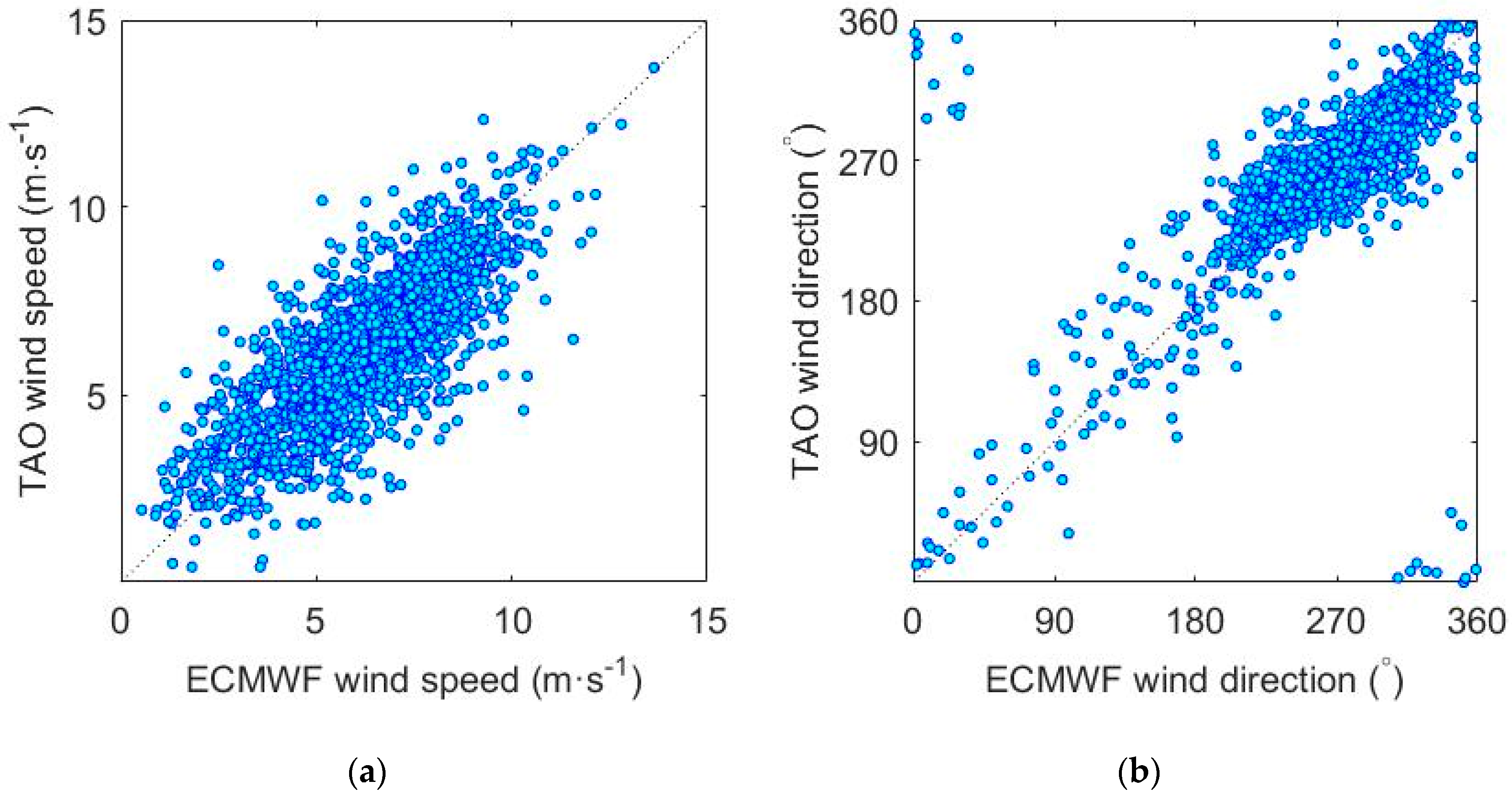
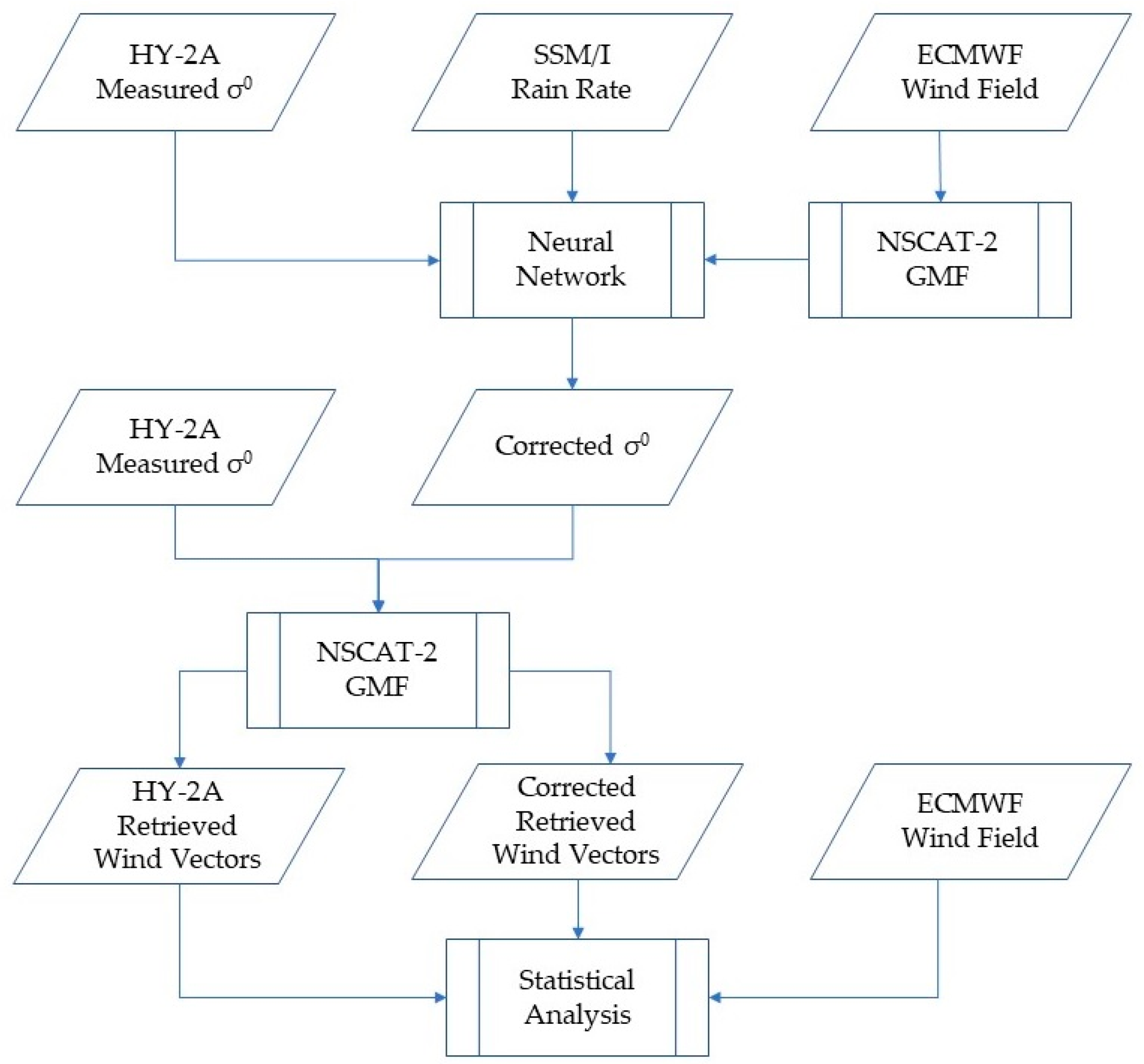

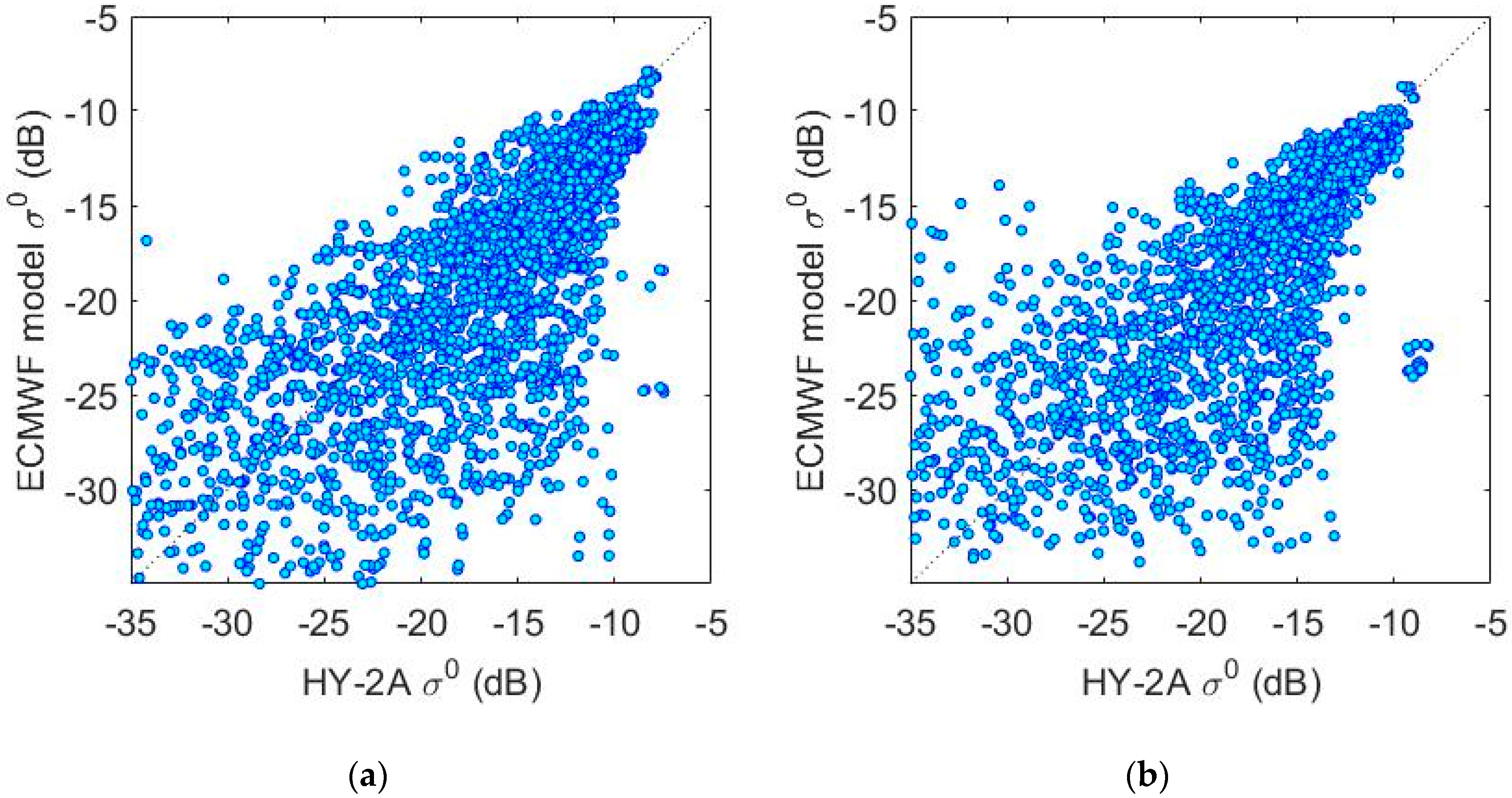
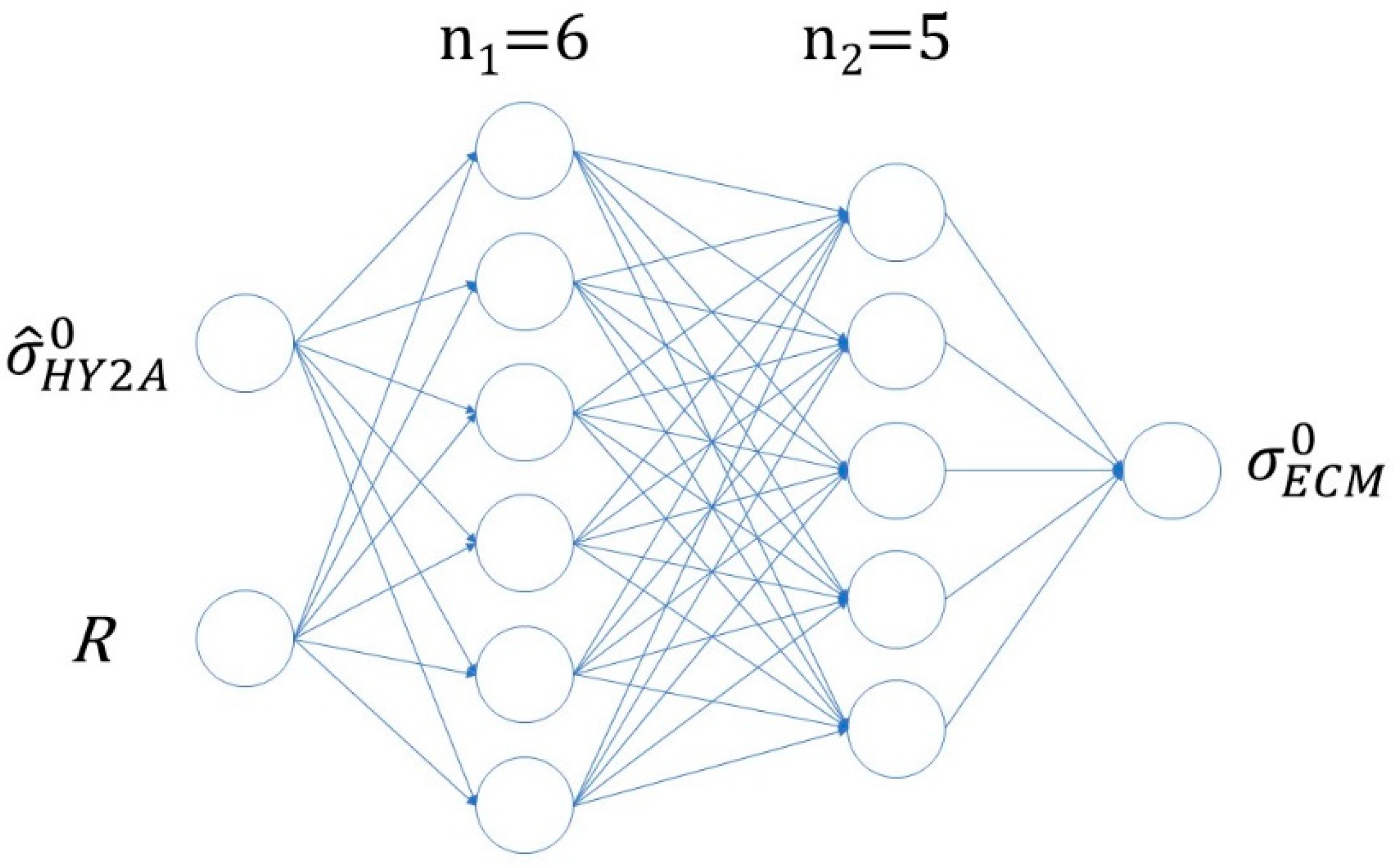
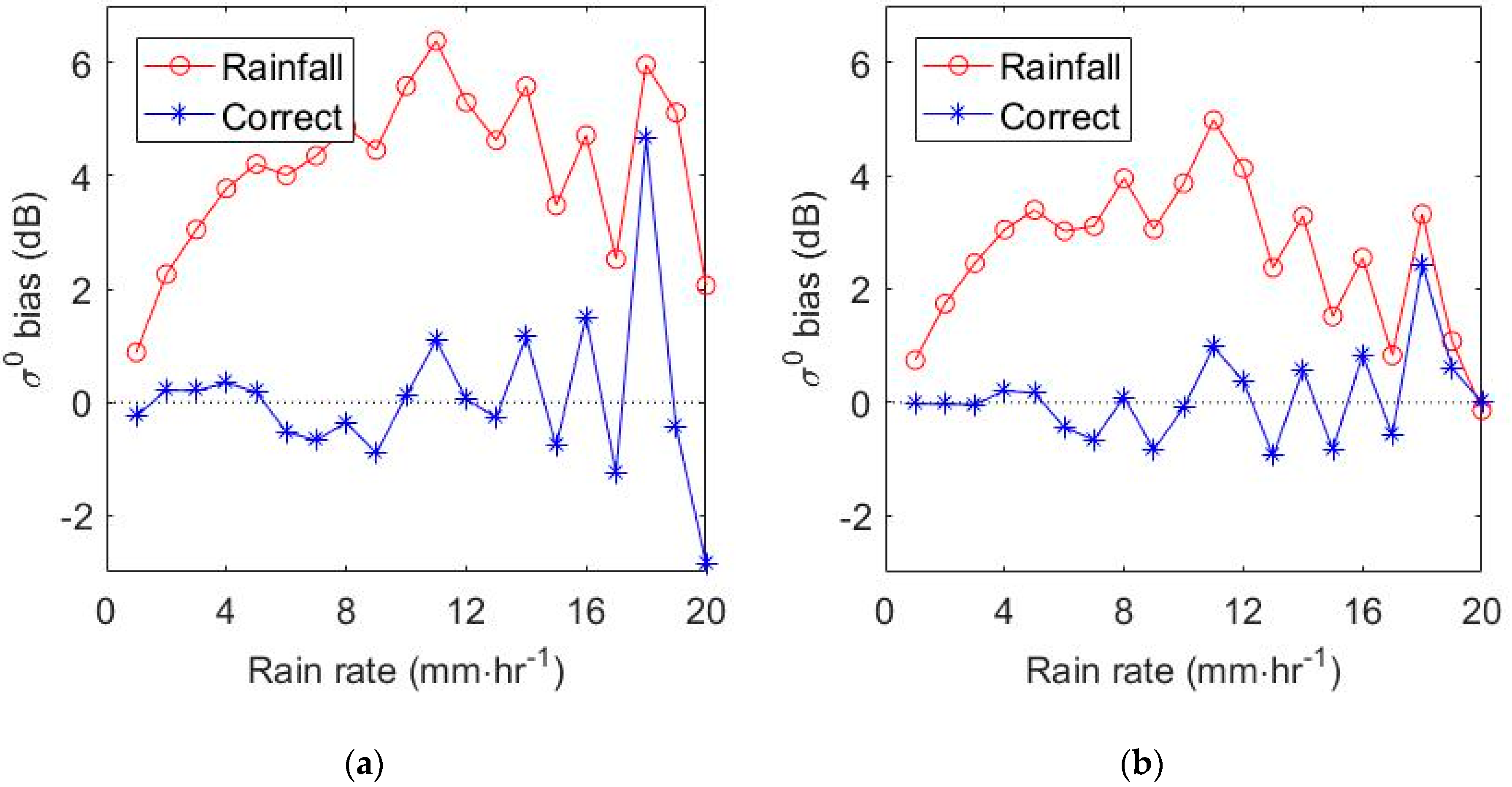
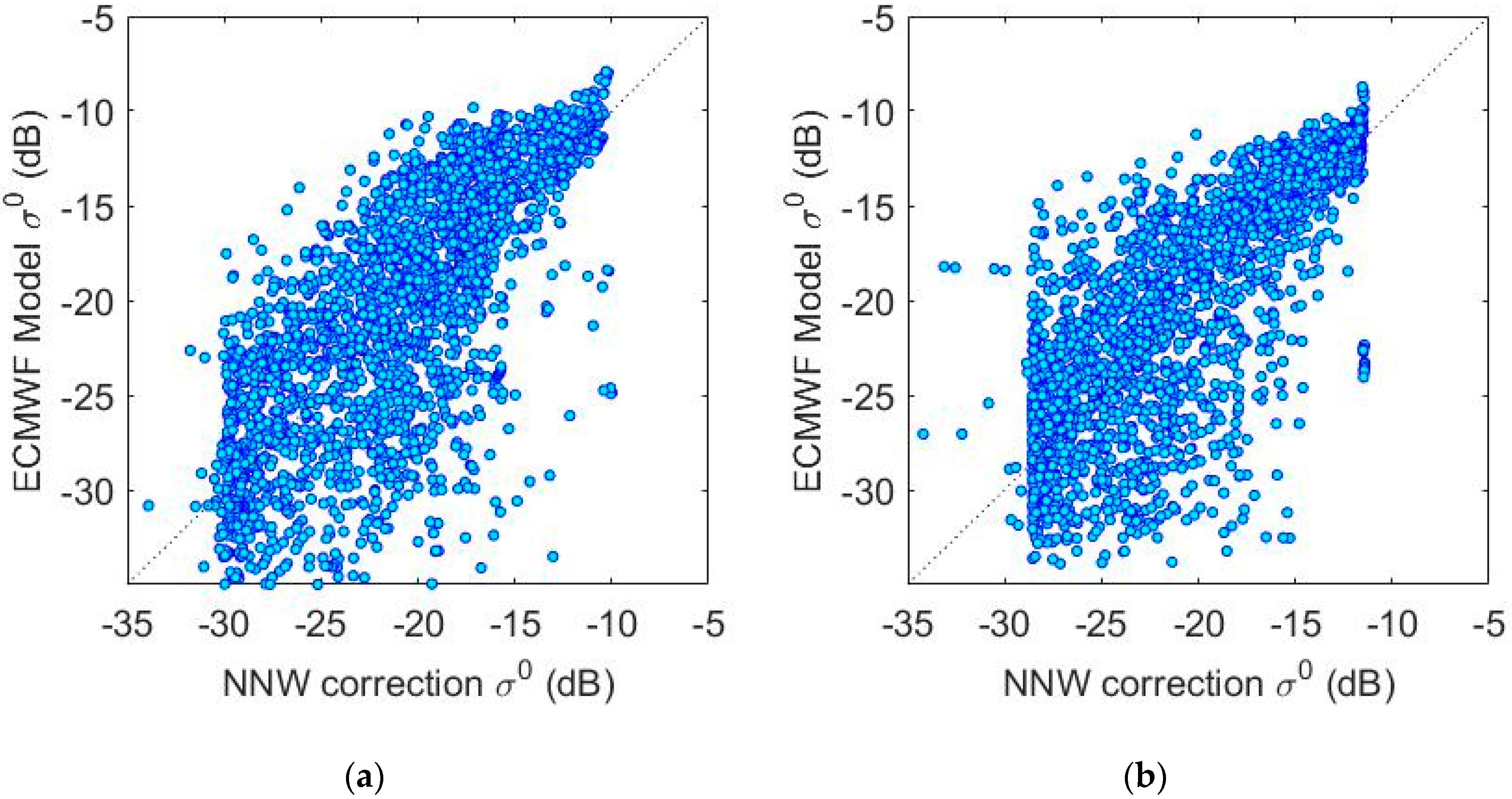
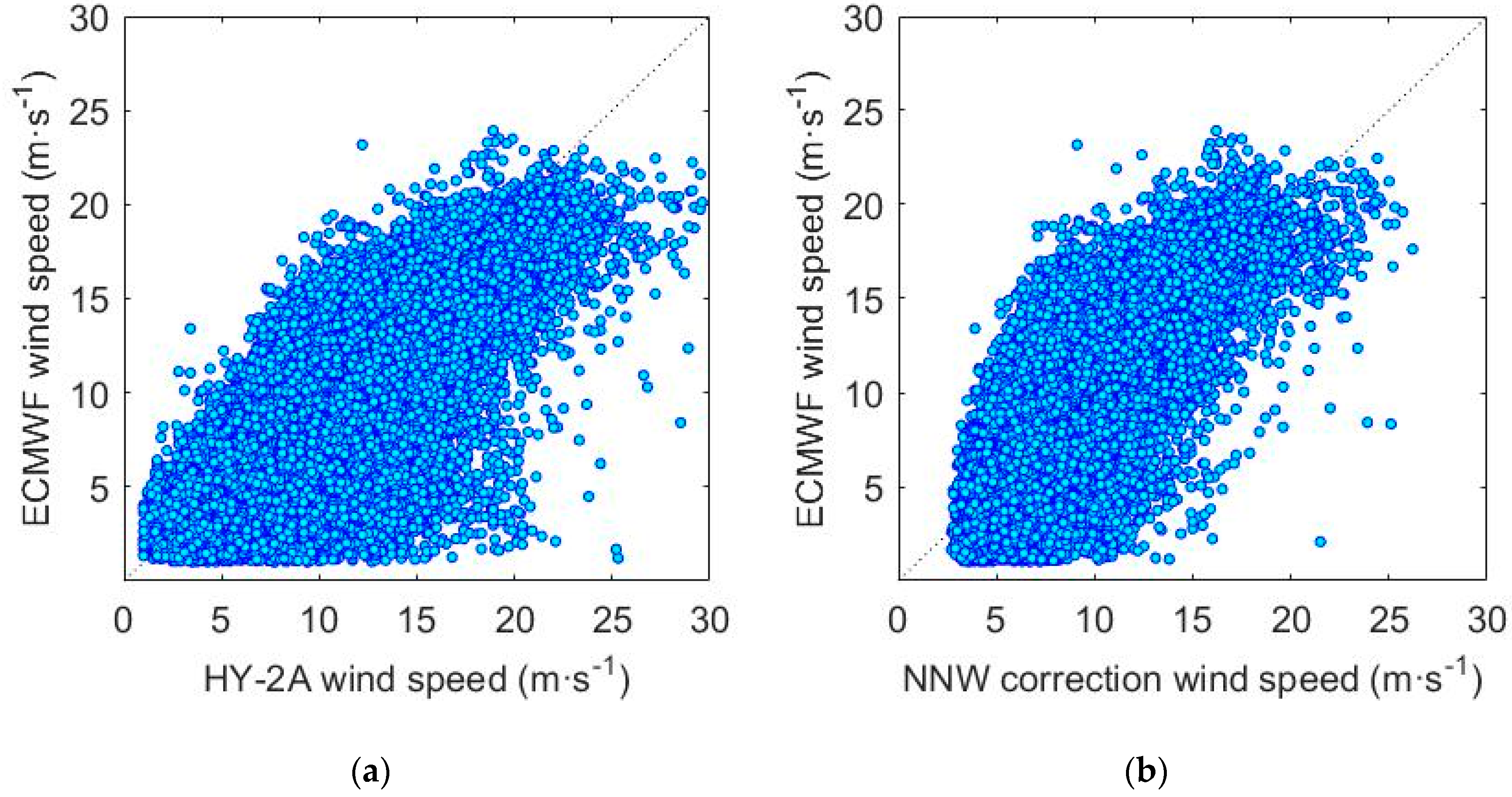
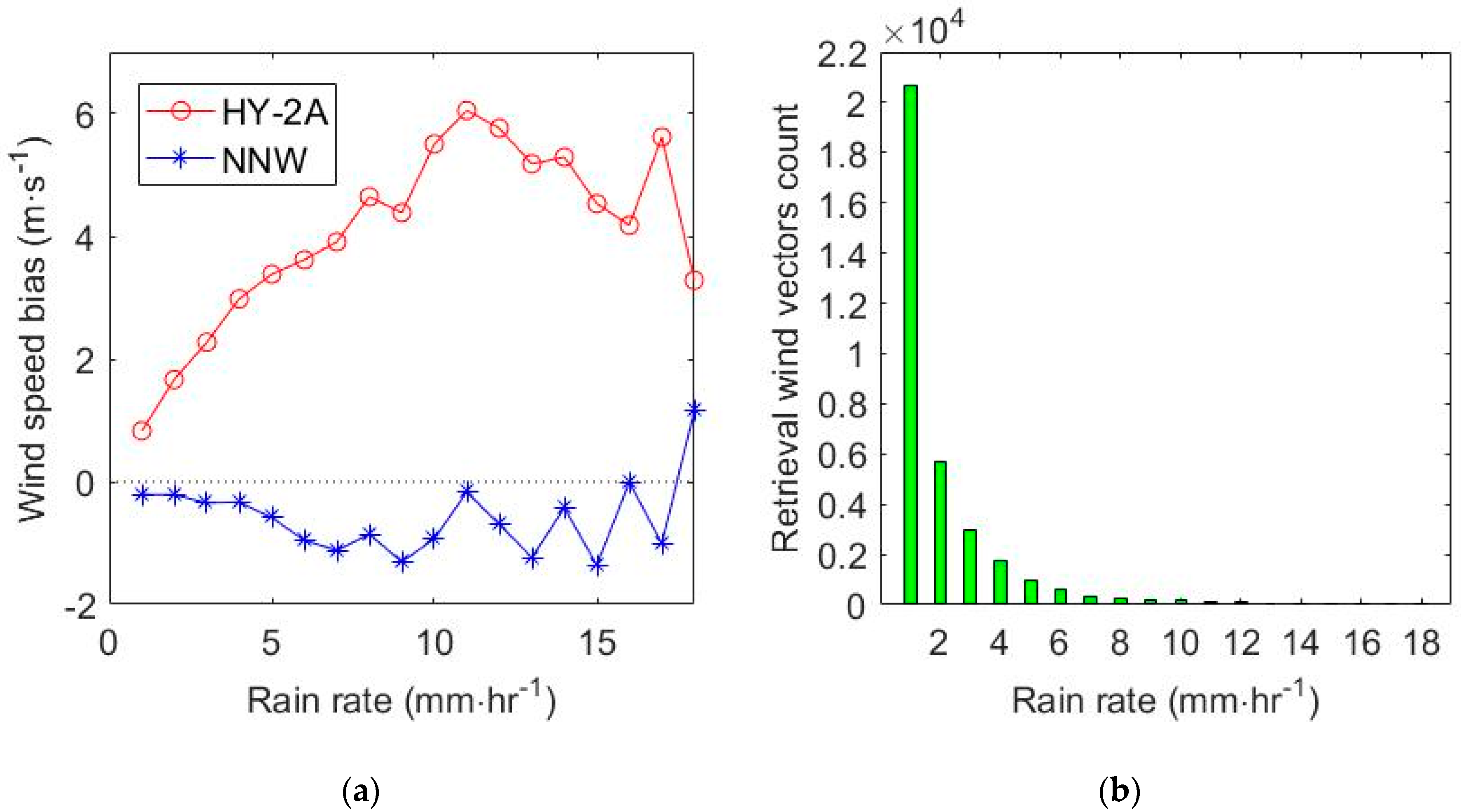
| Bias | Standard Deviation | |
|---|---|---|
| Wind speed | −0.0052 | 1.3467 |
| Wind direction | −1.6850 | 14.4374 |
| ECMWF Wind Speed (m·s−1) | HH-pol (dB) | VV-pol (dB) |
|---|---|---|
| 4 | −0.7971 | −0.5566 |
| 5 | −1.0560 | −0.7881 |
| 6 | −0.9248 | −0.7194 |
| 7 | −0.7961 | −0.5989 |
| 8 | −0.5841 | −0.4099 |
| 9 | −0.5713 | −0.3740 |
| 10 | −0.4625 | −0.3628 |
| 11 | −0.3737 | −0.3808 |
| 12 | −0.2744 | −0.3322 |
| 13 | −0.2369 | −0.2681 |
| 14 | −0.1091 | −0.1836 |
| 15 | −0.1398 | −0.0868 |
| 16 | −0.0161 | 0.0660 |
| 17 | 0.0540 | 0.1415 |
| 18 | 0.1506 | 0.1849 |
| 19 | 0.3270 | 0.3672 |
| 20 | 0.2786 | 0.3579 |
| 21 | 0.1800 | 0.3920 |
| 22 | 0.3108 | 0.2426 |
| 23 | 0.3420 | −0.0434 |
| 24 | 0.3595 | 0.1168 |
| Rain Rate (mm·h−1) | Bias (dB) | Standard Deviation (dB) | ||
|---|---|---|---|---|
| HH-pol | VV-pol | HH-pol | VV-pol | |
| 1 | 0.8810 | 0.7466 | 4.1424 | 3.7829 |
| 2 | 2.2617 | 1.7439 | 4.9233 | 4.2775 |
| 3 | 3.0509 | 2.4574 | 5.2822 | 4.7124 |
| 4 | 3.7765 | 3.0486 | 5.4344 | 4.8975 |
| 5 | 4.2057 | 3.3973 | 5.6749 | 4.8612 |
| 6 | 4.0059 | 3.0221 | 5.5687 | 4.6850 |
| 7 | 4.3507 | 3.1127 | 5.1113 | 4.5176 |
| 8 | 4.8547 | 3.9525 | 5.5316 | 5.1866 |
| 9 | 4.4541 | 3.0533 | 5.1893 | 4.2722 |
| 10 | 5.5866 | 3.8664 | 5.6583 | 5.2931 |
| 11 | 6.3803 | 4.9811 | 6.1590 | 5.6455 |
| 12 | 5.2945 | 4.1287 | 4.9196 | 4.8473 |
| 13 | 4.6243 | 2.3758 | 5.4799 | 4.3731 |
| 14 | 5.5802 | 3.2887 | 4.9369 | 4.3286 |
| 15 | 3.4754 | 1.5173 | 3.2906 | 2.9760 |
| 16 | 4.7115 | 2.5488 | 4.5584 | 4.1609 |
| 17 | 2.5286 | 0.8313 | 2.2679 | 2.1763 |
| 18 | 5.9594 | 3.3222 | 4.9391 | 3.9919 |
| 19 | 5.1164 | 1.0781 | 0.8102 | 0.8454 |
| 20 | 2.0640 | −0.1374 | 1.3660 | 0.9191 |
| Rain Rate (mm·h−1) | Bias (dB) | Standard Deviation (dB) | ||
|---|---|---|---|---|
| HH-pol | VV-pol | HH-pol | VV-pol | |
| 1 | −0.2464 | −0.0249 | 3.9849 | 3.5596 |
| 2 | 0.2119 | −0.0343 | 4.8096 | 4.1298 |
| 3 | 0.2066 | −0.0364 | 5.1780 | 4.5098 |
| 4 | 0.3428 | 0.2071 | 5.3084 | 4.5923 |
| 5 | 0.1802 | 0.1668 | 5.6049 | 4.5560 |
| 6 | −0.5262 | −0.4423 | 5.4973 | 4.4841 |
| 7 | −0.6743 | −0.6598 | 4.9751 | 4.2717 |
| 8 | −0.3543 | 0.0922 | 5.4282 | 4.9399 |
| 9 | −0.9041 | −0.8338 | 5.0255 | 4.0298 |
| 10 | 0.1220 | −0.0932 | 5.6152 | 5.0522 |
| 11 | 1.0956 | 0.9791 | 6.0642 | 5.6303 |
| 12 | 0.0564 | 0.3788 | 4.9257 | 4.7773 |
| 13 | −0.2753 | −0.9457 | 5.2984 | 4.3006 |
| 14 | 1.1617 | 0.5774 | 4.8559 | 4.1675 |
| 15 | −0.7756 | −0.8273 | 2.9729 | 2.9511 |
| 16 | 1.5096 | 0.8345 | 4.9001 | 4.1017 |
| 17 | −1.2580 | −0.5785 | 2.7115 | 2.1361 |
| 18 | 4.6514 | 2.4370 | 6.5655 | 3.9099 |
| 19 | −0.4357 | 0.6017 | 0.6838 | 0.7682 |
| 20 | −2.8396 | −0.0021 | 1.4918 | 0.9214 |
| Rain Rate (mm·h−1) | Bias (m·s−1) | Standard Deviation (m·s−1) | Count | ||
|---|---|---|---|---|---|
| HY-2A | NNW | HY-2A | NNW | ||
| 1 | 0.8278 | −0.2108 | 2.5246 | 2.3951 | 20,706 |
| 2 | 1.6651 | −0.2139 | 2.9567 | 2.8128 | 5663 |
| 3 | 2.2736 | −0.3476 | 3.2604 | 3.0367 | 3000 |
| 4 | 2.9814 | −0.3340 | 3.5217 | 3.1910 | 1755 |
| 5 | 3.3827 | −0.5870 | 3.7499 | 3.3487 | 942 |
| 6 | 3.6176 | −0.9561 | 4.0108 | 3.4617 | 574 |
| 7 | 3.9107 | −1.1194 | 4.1805 | 3.4155 | 342 |
| 8 | 4.6463 | −0.8556 | 4.3703 | 3.6356 | 270 |
| 9 | 4.3848 | −1.3092 | 4.4443 | 3.5175 | 201 |
| 10 | 5.5052 | −0.9315 | 5.1969 | 4.1480 | 150 |
| 11 | 6.0519 | −0.1681 | 5.3793 | 4.2121 | 125 |
| 12 | 5.7634 | −0.6955 | 4.6653 | 4.1094 | 102 |
| 13 | 5.1812 | −1.2388 | 5.3773 | 4.3665 | 60 |
| 14 | 5.2926 | −0.4256 | 4.7088 | 3.9735 | 44 |
| 15 | 4.5338 | −1.3620 | 4.0621 | 3.2983 | 24 |
| 16 | 4.1803 | −0.0086 | 4.0562 | 4.4334 | 18 |
| 17 | 5.6187 | −1.0113 | 3.4657 | 2.4364 | 10 |
| 18 | 3.2840 | 1.1590 | 4.7642 | 6.4780 | 4 |
© 2020 by the authors. Licensee MDPI, Basel, Switzerland. This article is an open access article distributed under the terms and conditions of the Creative Commons Attribution (CC BY) license (http://creativecommons.org/licenses/by/4.0/).
Share and Cite
Xie, X.; Wang, J.; Lin, M. A Neural Network-Based Rain Effect Correction Method for HY-2A Scatterometer Backscatter Measurements. Remote Sens. 2020, 12, 1648. https://doi.org/10.3390/rs12101648
Xie X, Wang J, Lin M. A Neural Network-Based Rain Effect Correction Method for HY-2A Scatterometer Backscatter Measurements. Remote Sensing. 2020; 12(10):1648. https://doi.org/10.3390/rs12101648
Chicago/Turabian StyleXie, Xuetong, Jing Wang, and Mingsen Lin. 2020. "A Neural Network-Based Rain Effect Correction Method for HY-2A Scatterometer Backscatter Measurements" Remote Sensing 12, no. 10: 1648. https://doi.org/10.3390/rs12101648
APA StyleXie, X., Wang, J., & Lin, M. (2020). A Neural Network-Based Rain Effect Correction Method for HY-2A Scatterometer Backscatter Measurements. Remote Sensing, 12(10), 1648. https://doi.org/10.3390/rs12101648






